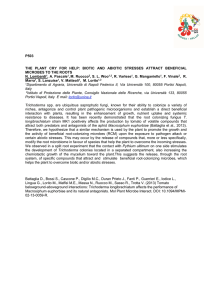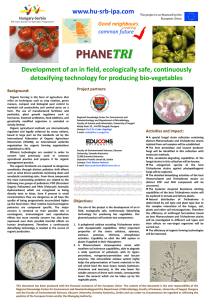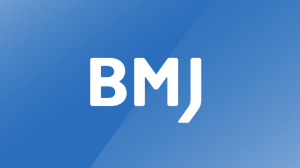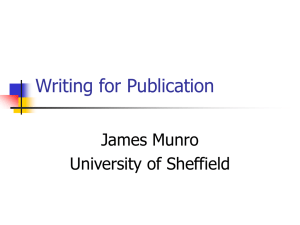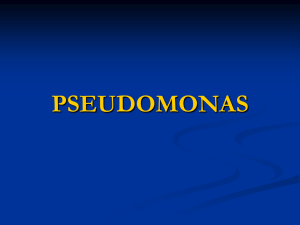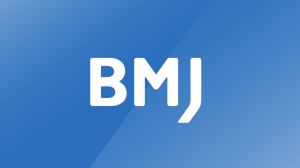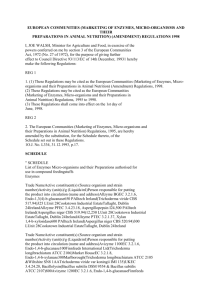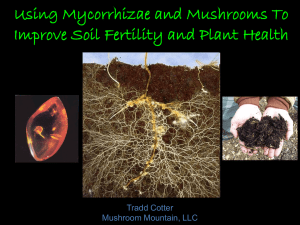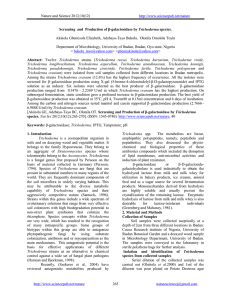Use of Trichoderma, Pseudomonas and Bacillus spp. in
advertisement
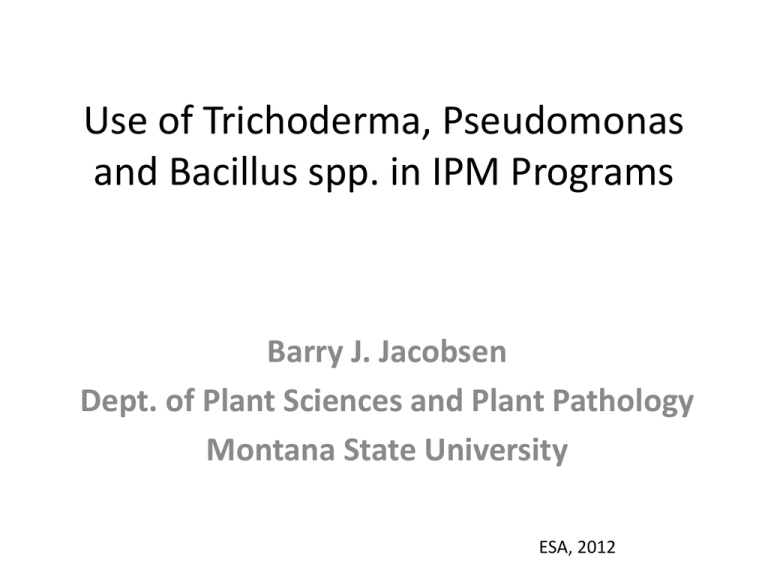
Use of Trichoderma, Pseudomonas and Bacillus spp. in IPM Programs Barry J. Jacobsen Dept. of Plant Sciences and Plant Pathology Montana State University ESA, 2012 Typically used as seed, tuber, rhizome, root stock, and soil treatments Widely used in IPM CRSP activities in South Asia Many products in both developed and developing world Widespread acceptance by farmers after comparison to farmer practices that include pesticides- increase yield, quality, earlier harvest, profitability-100s of trials Mechanisms for Biological Control of Plant Pathogens • Antibiosis-Biological Control Agent (BCA) produces antibiotic substance that suppresses pathogen. Pseudomonas, Bacillus, Trichoderma • Competition for nutrients-BCA competes for resource in short +++ supply that pathogen needs. e.g. Fe , sugars and other needed for spore germination or growth. Pseudomonas • Niche occupation-BCA occupies infection niche • Predation • Parasitism. Trichoderma, Bacillus penetrans-nematode • Alter plant physiology (transpiration, water relations, growth hormones, nutrient uptake, N fixation) • Induced resistance. Pseudomonas, Bacillus, Trichoderma • MOST BCAs HAVE MULTIPLE MECHANISMS Rhizosphere – PGPR-Plant growth promoting rhizobacteria and Trichoderma colonize Rhizosphere/endosphere • • • • • Pseudomondas Enterobacter Bacillus Azospirillum Many others Rhizosphere colonist produce antibiotics,etc Antagonistic to pathogens Induce plant defense genes systemically Colonize rhizosphere occupy infection courts Tie up critical nutrients needed by pathogens, produce growth promoting substances Colonization (CFU/g ) of sugarbeet by 341-16-5 from treated seed 15C=1.13 e5 24C=7.59e 5 7.1 e5 2.1 e5 1.3 e5 1.5 e5 Many PGPR are endophytes 2.1 e5 5.4 e5 Growth promotion by PGPR Control of root pathogens, growth regulators, improved nutrition, induced resistance? Healthy seedling protected by PGPR Trichoderma Damping-off Mixing Trichoderma product in potting medium Planting Trichoderma/PGPR colonized seedlings Begonias were grown in the greenhouse and inoculated with Botrytis cinerea under conditions optimal for the development of disease. Treatments left to right : untreated (Un), CaCl2, chlorothalonil (Fung), and the biocontrol agent Trichoderma hamatum T382 inoculated into the potting mix (T382). Hoitink, et al Competition for nutrients • Many rhizosphere colonizing Pseudomonads (PGPR), Serratia, Erwinia (Pantoea) provide disease suppression by competition for Fe+++ with pathogens via chelation by siderophores (pyroverdin, pseudobactin, pyochelin). – Fusarium wilts of flax, carnation, Take-all, Thielaviopsis, Rhizoctonia, Sclerotium rolfsii, Erwinia carotovora, several patch diseases of turf, dollar spot of turf(Sclerotinia), melting out of turf (DrechsleraBipolaris), DRBs, Deliterious rhizobacteria that produce HCN, - may also be SAR/ISR signaling agents – Fireblight• Pantoea agglomerans competes for nutrients and niche with Erwinia amylovora, • Pseudomonas fluorescens A 506(Blight Ban)- Fe+++ allows production of antibiotic antagonistic against E. amylovora that allows competition for site-this is used commercially • PGPR competes for nutrients (root exudates) with slower growing pathogens-fungistasis, chlamydospores, macroconidia, oospores Altered physiology • Trichoderma harzianum/viridae-improve water and nutrient uptake- many references • Bacillus subtilis (Kodiak, other), Bacillus- pumillus GB 34 (YieldShield), Azospirillum, Pseudomonas – Auxins- Asghar et.al.,2002, Idris et.al. 2007 – Gibberelins-Joo, et.al.2005 – Cytokinins-Garcia de Salmone, 2001, Castro, et.al. 2008, Dobbelaere,et.al. 1999. – P uptake-Ramirez and Kloepper, 2010 (phytase activity) – Improved N utilization-Shoebitz et.al. 2009-nitrogenase and IAA – improved water relations Phyllosphere/Phylloplane Biological Control • Environment for BCA in this environment is relatively hostile compared to rhizosphere / endosphere. – Physical environment: great flux in moisture, relative humidity, UV/IR radiation, paucity of nutrients that change with leaf age and time – Biological environment: competition with phylloplane colonists and invaders, plant responses and exudates vary with physiological age, genetics, etc • Majority of products are oriented to greenhouse or controlled storage situations where environment is more stabile. – Even here BCA performance has greater variability than chemicals • Vast majority of research has focused on Botrytis, powdery mildew and fruit storage molds. – Significant markets-high value of vegetables, ornamentals and fruit – Fewer registered pesticides-fungicide resistance problems • Lower costs to register BCAs in many countries – BCAs considered more acceptable to greenhouse workers periods) and to consumers (reentry Pseudomonas syringae ESC 10/11 antibiosis and niche occupation Induced Resistance=SAR,SIR and ISR Common mechanism for Pseudomonas, Bacillus, Trichoderma • SAR-Systemic Acquired Resistance-SIR-Systemic Induced Resistance – Activation of master switch via salicyclic acid pathway signal –Classical PR-Proteins-Chitinases, β glucanases, proteinases, etc • ISR-Induced Systemic Resistance – Activation via jasmonic acid/ ethylene pathway -no classic PR-proteins but the defense compounds – Usually associated with PGPR(plant growth promoting rhizobacteria( Pseudomonas sp.)-insects Induced Resistance now we know that many biological inducers induce via salicylic acid, NPR-1 gene, jasmonic acid, ethylene or combination of these pathways Induced resistance • Seed Treatments: Pseudomonas, Bacillus, Trichoderma-root diseases caused by fungi, nematodes-foliar diseases caused by bacteria, fungi, viruses • Foliar treatments: Bacillus mycoides-foliar diseases caused by bacteria, fungi, virusesRoot diseases caused by Pythium PGPR induced resistance is a state of enhanced defensive capacity developed by a plant reacting to specific biotic or chemical stimuli Stimulus from PGPR/Trichoderma Stimulus Stimulus Stimulus PGPR induced resistance is a state of enhanced defensive capacity developed by a plant reacting to specific biotic or chemical stimuli potentiated induction of stressrelated genes enhanced resistance SAR/ISR-Foliar Induction Protective effects of SAR extend to all plant parts Resistance is detectable 2-3 days post induction Peaks 5-7 days post induction Point of induction Effective for ~14-20 days or longer Suppresses many pathogens: fungi, bacteria, viruses 22 Trichoderma harzianum/viridae Fungal Parasite Antibiotic producer Improved water and nutrient uptake Induced Systemic Resistance Inducer Trichoderma viridae and antibiotic deficient mutants Trichoderma antibiotic deficient mutants still retain biocontrol activity Mycoparasitism deficent mutant Trichoderma mycoparasitism deficient mutants still produce biocontrol Mycoparasitism and ISR Phase 1: high MW Phase 2: low MW CWDEs receptors? host Trichoderma Antibiotics host Trichoderma Antibiotics CWDEs Cell wall degrading enzymes The pre-contact events of mycoparasitim may also activate ISR in the plant Lorito PGPR- Viruses • 1996- Raupach et al. Two strains of PGPR induce ISR in cucumber and tomato against CMV • Some strains of Pseudomonas fluorescens, Bacillus pumilis, B. amyloliquefaciens, B subtilis, Kluyvera cryocrescens rhizobacteria reduced CMV and Tomato Mottle geminivirus infection (50-70%), reduced symptoms and lengthened period from infection to symptom development-Zehender et al, 1999 • Bacillus globisporus, Pseudomonas fluorescens, Streptomyces gibsonii-30-60% reduction of tobacco necrosis virus local lesions in bean. Shoman, et al 2003 • Pseudomonas fluorescens- Barley Yellow Dwarf Mosaic- Mysus avenae-Wheat and Barley~50% reduced disease severity. Al Ani et al.2011 BmJ Virus Disease Control mechanical transmission Virus Latent period - % days symptomatic plants Virus titer Symptomatic plants 6.7 75 2.37 BmJ TMV-tomato 9.0 25 0.49 water 4.8 82 2.35 BmJ 8.3 24 1.1 CMVcucumber water 28 PVY Greenhouse-mechanical transmission Treatment Dead BmJ +PVY Dead BmJ BmJ induction 5 days before inoculation with PVY + BmJ @ 14, 28, and 42 days post inoculation % PVY Average 58.3 a 0c 26.6 b 2010 Greenhouse PVY Aphid Transmission March-May Aphid Transmission of PVY Transferred 10 green peach Aphid/ plant from PVY infected potato- 20 replications summary of 3 experiments % infection ELISA 45% 40% 35% 30% Distilled Autoclaved BMJ 25% BMJ 20% No Treatment 15% 10% 5-May 3-May 29-… 27-… 25-… 23-… 21-… 1-May Date Tested 19-… 17-… 15-… 13-… 11-… 9-Apr 7-Apr 5-Apr 3-Apr 1-Apr 30-… 28-… 26-… 0% 24-… 5% Hermiston, OR- Integrated PVY Management Plots Red flags- Russet Norkotah-Mazzama Borders Treatment 2010 % PVY total 2011 % PVY total including winter including winter test test BmJ WP 2.0 oz/A 14 days emergence to harvest 3.5 10.4 BmJ WP 2.0 oz/A 14 days emergence to harvestrogue out infected plants 1.5 4.7 Admire Pro 8.7 oz @ plant +BmJ WP 2.0 oz/A 14 days emergence to harvest @ 60 days post emergence Assail 1.7 oz, 67 days Fulfill 5.5 oz, 75 days Beleaf 2.8 oz, 87 days Leverage 3.8 oz-rogue out infected plants 3.0 5.3 Admire Pro 8.7 oz @ plant @ 60 days post emergence Assail 1.7 oz, 67 days Fulfill 5.5 oz, 75 days Beleaf 2.8 oz, 87 days Leverage 3.8 oz-rogue out infected plants 4.5 7.6 Untreated 10.0 10.0 Flsd 0.05 5.9 5.3 How does induced resistance reduce virus • Direct effect on insect vector-JA? • Love, et al., 2007 showed salicylic acid pathway involved in delayed symptoms and severity and alternative oxidase. • Ethylene/Jasmonic acid deficient mutants implicate ISR in reduced long distance spread in plant . • Lewsey et al., 2009 showed RNA silencing and salicylic acid mediated defense to restrict virus replication and movement. Jasmonic acid may have direct effect on aphid vector. • Data using salicylic acid, Acibenzolar-s-methyl-(Actigard,Bion)/ CMV TMV in tobacco, squash, Arabidopsis show reduced virus movement-cell to cell (delay symptom development) and systemic movement. IR involves mitochondrial enzyme alternate oxidase and RNA dependent RNA polymerase. – Mayers, et al 2005 : Madhusudham, et al., 2008 Conclusion • IR shown to delay symptom onset and reduce infection, disease severity, virus titer, virus movement or symptom severity for a wide range of viruses .. • Control levels are generally in the range of 3080% and that the mode of action or efficacy differs remarkably by biological control agent and plant species. • May have direct effect on aphid vectors Thank You &Happy Trails

